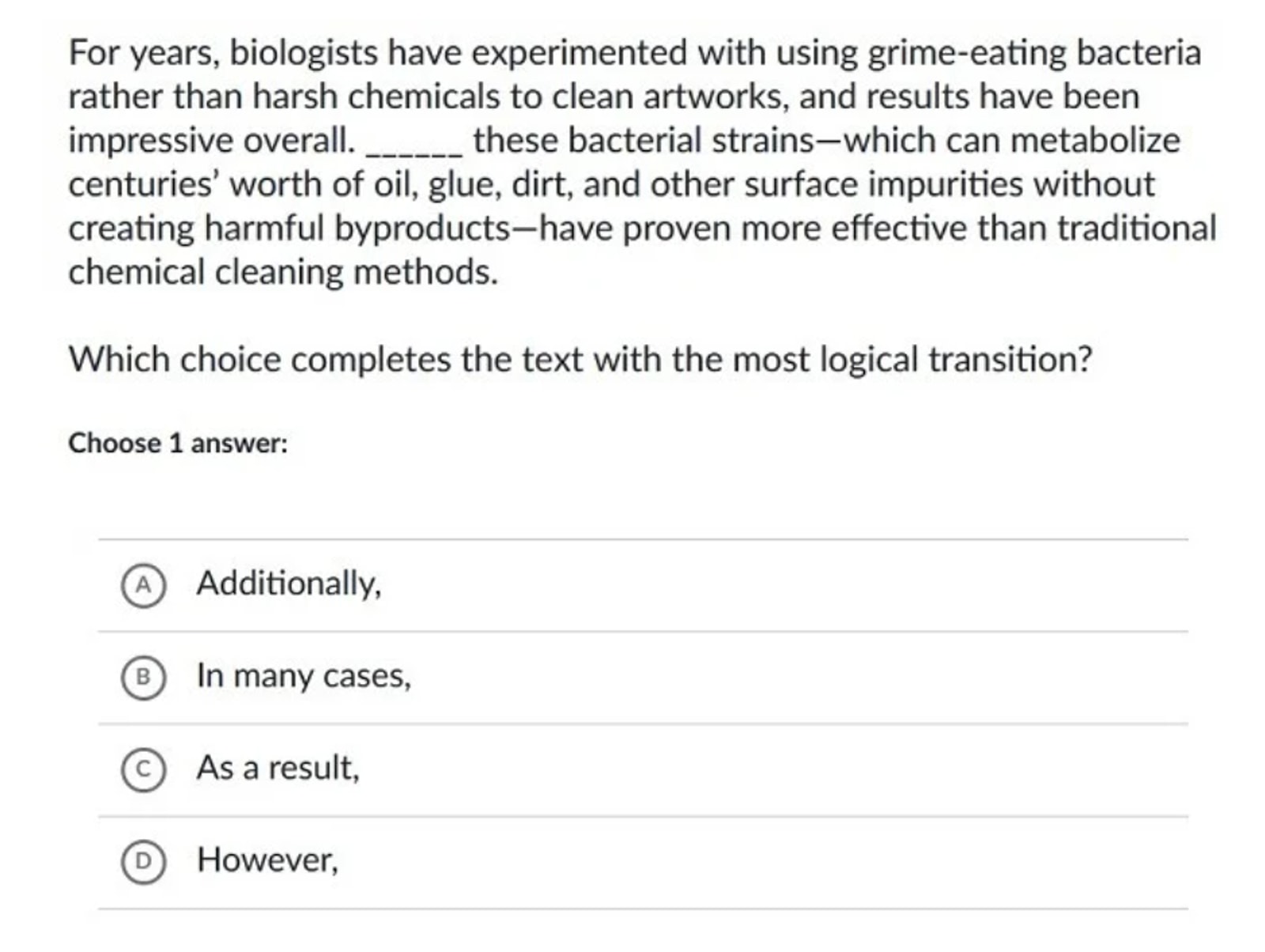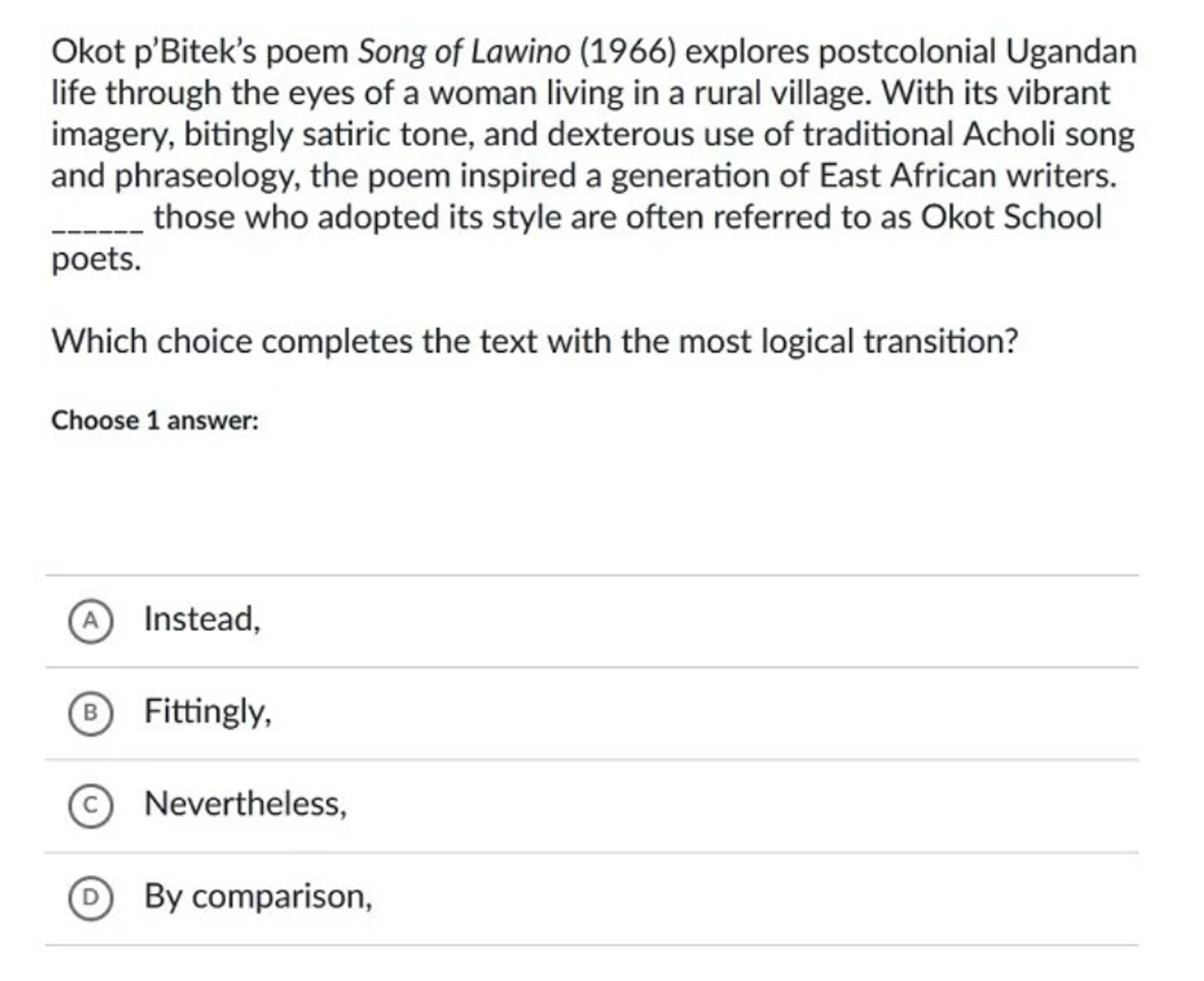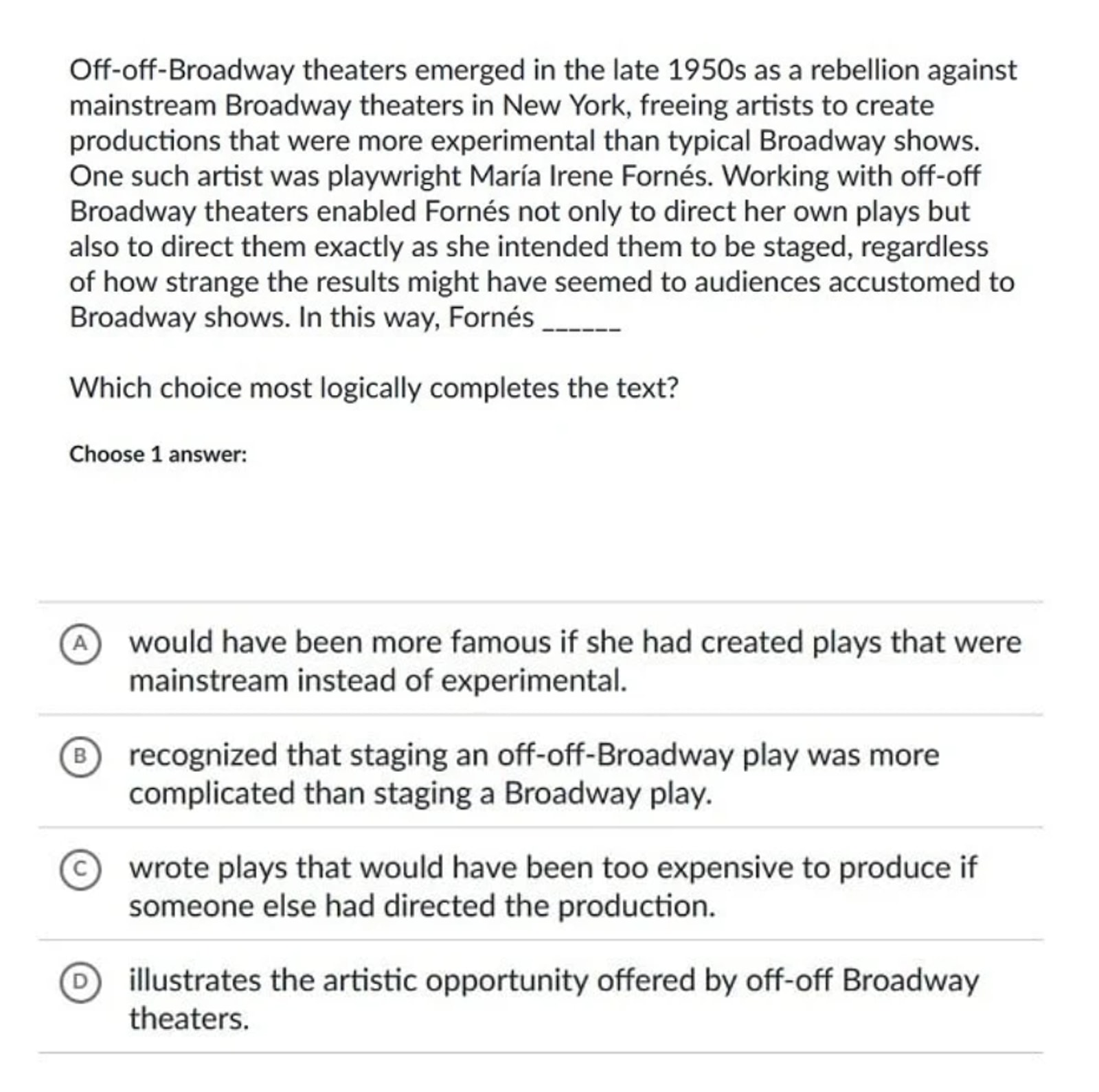Transition Questions on SAT Reading and Writing: Tips and Examples
Author
Hartwell
Date Published

Transitions are essential in writing because they create logical links between ideas. In the SAT Reading and Writing section, questions about transitions form an important part of the exam. This article will explain the different types of transition questions on the SAT and offer advice on how to answer them correctly.
What Are SAT Transition Questions?
There are two main types of transition questions. The first type asks you to choose the transition word that fits best in a sentence. Examples of transition words are “moreover,” “therefore,” and “nevertheless.”
The second type of transition question, sometimes called an inference question, asks you to select the phrase or sentence that logically connects with or follows another part of the passage.
Type #1: Transitional Words
Choosing the correct transitional word or phrase to complete a sentence requires you to understand how these words are used. On the SAT, questions about transitional words usually focus on three main types of relationships: addition, contrast, and causation.
Addition: Words like “furthermore” or “moreover” that add information or continue a thought.
Contrast: Words like “despite” or “although” that show a difference or introduce opposing ideas.
Causation: Words like “since” or “because” that show a cause-and-effect relationship.
Below are some example sentences. Notice how the transition words connect the ideas logically in each sentence.

Not every transition word fits neatly into these three groups, but thinking about transitions this way will help you answer these questions correctly.
Most transition word questions on the SAT ask you to link two sentences with the appropriate transition. Here is a simple example:

Because people do not usually expect someone who never studies to get perfect grades, you should use a contrast word. Only answer choice C makes sense in this context.
Key Transition Words
Here are the most common transition words, grouped by their type. Learn these words and understand which category each one belongs to.

How to Approach Transition Word Questions
Follow these steps to answer transition word questions correctly:
Read the Entire Passage
Make sure you read all the sentences so you fully understand the context and relationship between ideas.
Think About Which Word You Would Use
Decide which transition word would best connect the sentences. You might find this word—or a similar one—among the answer choices.
Identify the Relationship
Figure out if the sentences show addition, contrast, or causation. If you’re not sure, consider if you would use words like “and” (for addition), “but” (for contrast), or “so”/“because” (for causation).
Eliminate Wrong Choices
Remove answers that do not fit the meaning or are not grammatically correct.
Plug in Your Choice
Place the chosen transition into the sentence and check if the passage now makes sense.
SAT Example Questions
Use these steps to answer SAT transition word questions:

In the first example, the blank is at the beginning of the second sentence. The first sentence says that scientists have achieved impressive results using grime-eating bacteria. The second sentence gives more details about what the bacteria can do. This means you need an addition transition. “In many cases” is the best choice, so the correct answer is B.
Let’s review the other choices. Choice A would only work if the second sentence was explaining the first. Choice C fits if there was a cause-and-effect relationship. Choice D, “However,” is only correct if the second sentence contrasts with the first. Since this is not the case, B is correct.
Now try another SAT example:

Here, two sentences give an overview of Okot p’Bitek’s poem, Song of Lawino. The blank is at the start of the third sentence, which adds more information about other writers who used the same style. This sentence is an example of an addition transition.
Among the answer choices, A, C, and D are contrast transitions, which do not fit here. Choice B, “Fittingly,” is an addition transition. It is suitable because it connects to how the writers took inspiration from Okot p’Bitek and became known as the Okot School poets. Therefore, B is the correct answer.
Type #2: Inferences — Transitional Phrases and Sentences
The second type of transition question asks you to select the phrase or sentence that logically connects with the information in the passage. These are often called “inference” questions. On the SAT, they usually appear as:
Which choice most logically completes the text?
In other words, these questions require you to choose the option that either sets up upcoming information or follows logically from what was already mentioned.
Step-by-Step Approach to Inference Questions
Since every question is a bit different, your approach may vary slightly based on what is being asked. Here are the general steps:
Pay Attention to What the Question Is Asking
Make sure you understand exactly what is being asked. For example, some questions will want a sentence that introduces the information that follows, while others may want a sentence that continues from the previous idea. Be careful to answer the question correctly.
Read What’s Needed
If the question asks which choice logically follows the previous sentence, you should read both that sentence and the one before it. If the question wants a sentence that sets up the rest of the passage, glance through the remaining passage. Sometimes it’s helpful to skip this question at first and return to it after reading more of the passage.
Summarize the Key Information
Read and briefly summarize the most important ideas from the sentences or paragraphs the question refers to. For instance, if the question asks which choice sets up the next paragraph, read that part and think about its main idea. Summarizing makes it easier to pick the best answer.
Narrow Down Your Choices
Eliminate any answer choices that do not make sense or do not logically connect the sentences. The best answer will make the sentences flow smoothly.
Test Your Choice
Place the answer you think is best into the passage and check if the text makes logical sense.
Real SAT Examples
Here’s how you can use these steps on real SAT questions:

In one example, the passage ends with the phrase, “This finding suggests that _____.” The main points of the passage are:
Online shopping does not allow people to touch products before buying.
People who touch products are willing to pay more for them than those who do not.
So, you need to pick an answer that supports these points.
Answer A is incorrect because it does not support the key idea that touching an item leads people to pay more.
Answer B is wrong because the passage does not say this is true; it goes against the second point.
Answer C is unrelated, as it introduces new information about monthly spending that is not discussed in the passage.
Answer D says that being able to see and touch a product in person makes it more valuable to the shopper, which matches the main point and is supported by the text. Therefore, D is the correct answer.
Let’s try another example:

This passage talks about the playwright Fornés working in off-off Broadway theaters. The key points are:
Off-off Broadway theaters allowed more experimental plays than traditional Broadway theaters.
Fornés could direct her plays as she wished, even if audiences found them unusual.
This supports the idea that Fornés benefited from the artistic freedom these theaters provided.
Answer A is incorrect because it talks about fame, which is not mentioned.
Answer B is wrong because play complexity is not discussed.
Answer C is unrelated, since production costs are not mentioned.
Answer D is correct because it references artistic opportunity, which matches the key ideas of the passage.
Review: Key Strategies for Answering Transition Questions
Here are the most important strategies to use when you face transition questions on the SAT:
Identify the Type of Relationship
For every transition question, think carefully about how the sentences or ideas are connected. Knowing whether the relationship is addition, contrast, or causation will help you choose the right transition.
Read Carefully and Understand the Context
Always read the question and enough of the passage to be sure you know what is being asked. Make sure you understand the context before picking your answer.
Use the Multiple-Choice Format to Help You
If you notice two answer choices that mean almost the same thing, neither one is likely to be correct. Start by eliminating answers that are clearly wrong.
Test Your Answer in the Sentence
Put the answer you think is best back into the sentence. Make sure the transition word or phrase makes the sentence sound logical and clear in its context.
Related Posts

Unlock your SAT potential with these 5 essential reading strategies focused on evidence command. Improve comprehension and boost your score!

Unlock your potential with proven strategies for tackling SAT reading passages, enhancing comprehension, and improving your test scores!